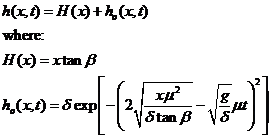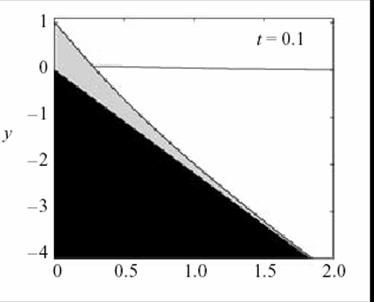Benchmark Problem #3
TSUNAMI GENERATION AND RUNUP DUE TO A TWO-DIMENSIONAL LANDSLIDE
Here the modelers will be asked to predict the free surface elevation and runup associated with a translating Gaussian shaped mass, initially at the shoreline. In dimensional form, the seafloor can be described by:

δ = maximum vertical slide thickness, μ = thickness/slide length, and β is the beach slope. Once in motion, the mass moves at constant acceleration. The initial position of the block is shown in the figure below which shows the start of the motion.

The modelers will have to provide snapshots of the free surface at selected times. The following two setups will be benchmarked:
CASE A: tanβ/μ = 10 -> β= 5.7°, δ=1m, μ=0.01
CASE B: tanβ/μ = 1 -> β= 5.7°, δ=1m, μ =0.1
Four comparisons should be made for each setup. Spatial snapshots of the free surface are given at four different non-dimensional times:
CASE A:  =0.1, 0.5, 1.0, 1.5 =0.1, 0.5, 1.0, 1.5
CASE B:  =0.5, 1.0, 2.5, 4.5 =0.5, 1.0, 2.5, 4.5
The data files are named as readme1.txt, bench3A_t05.txt, bench3B_t10.txt, bench3A_t15.txt, bench3B_t05.txt, bench3B_t10.txt, bench3B_t25.txt, and bench3B_t45.txt . Included in each data file are four columns of data: x(m); H(m); ho(m); (m). The free surface elevations, z, are those predicted by an analytical solution. Agreement with CASE B using any model other than the linear shallow water wave equations may be poor. For more information, please refer to Analytical solutions for forced long waves on a sloping beach by Liu, Lynett and Synolakis (Journal of Fluid Mechanics, 478, 101-109, 2003).
|



 =0.1, 0.5, 1.0, 1.5
=0.1, 0.5, 1.0, 1.5 =0.5, 1.0, 2.5, 4.5
=0.5, 1.0, 2.5, 4.5